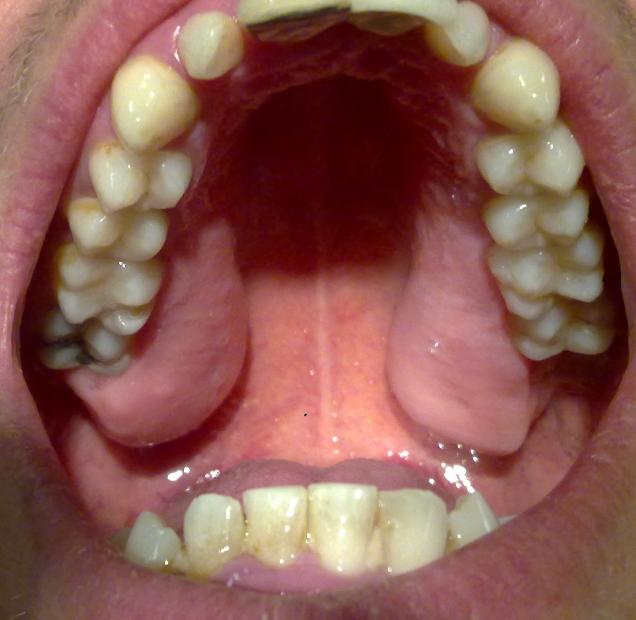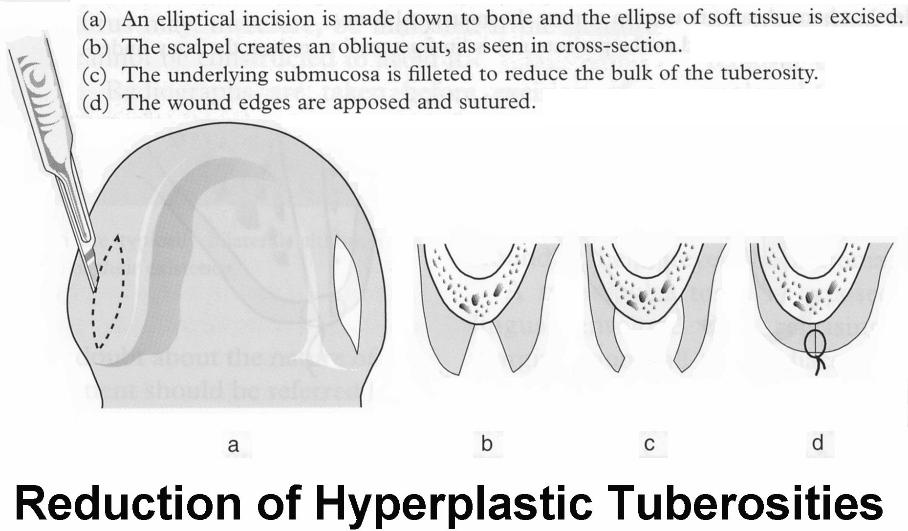What Is the Tuberosity?
A tuberosity is a rounded bony protrusion behind your last molar in the upper jaw. It is covered by your gum.
A tuberosity reduction makes the tuberosity less prominent / smaller.
If you have all of your teeth, an enlarged tuberosity usually is not a problem. However, if you lose your upper teeth and need a denture, an enlarged tuberosity may hang down beyond the rest of your upper jaw, which makes it difficult for a denture to fit properly. The upper denture stays in place because it makes a seal with your jaw and the roof of your mouth (palate). An enlarged tuberosity can make this seal difficult to achieve.
Tuberosity reductions are not as common today because dental implants are becoming more popular and as fewer people lose all their teeth and need upper dentures.
However, some people with teeth and some who are receiving implants in their upper jaw may also need this procedure. If the tuberosity is enlarged, it can interfere with the way the teeth and jaws come together (occlusion). A tuberosity reduction can fix the problem.
Preparation
An Oral Surgeon usually performs a tuberosity reduction, in coordination with a general dentist or a dentures specialist (prosthodontist).
In some people, the sinus cavity (antrum) extends into the tuberosity. The Oral Surgeon needs to know where your sinus cavity is in relation to the tuberosity, so you may need X-rays before the procedure.
Your dentist / prosthodontist may make a plastic mold of your jaw to show the Oral Surgeon how much bone +/- soft tissues need to be removed. To make the mold, your dentist will take an impression of your jaw, make a plaster cast and grind down the tuberosity areas of the cast to the proper level.
The mold fits over your gums like a denture. During the procedure, the Oral Surgeon will test the mold in your mouth to make sure enough bone and tissue have been removed. In most people, only the bulbous soft tissue needs to be trimmed and removed.
The tuberosity is numbed up with local anæsthesia; if you are nervous or anxious, sedation in conjunction with the local anæsthesia, can be used.
The oral surgeon will remove the extra gum tissue from the tuberosity, and, in some cases, trim down the bone underneath. If a mold has been made, it will be tested in your mouth.
Once the oral surgeon has removed enough gum tissue +/- bone, the oral surgeon will stitch the operation site closed. The procedure usually takes less than an hour.
Follow-Up
You will be advised as to what pain-killers to take; also, you may be prescribed antibiotics, if though clinically appropriate. Post-operative instructions will be given. The stitches fall out 2 – 3 weeks post-operatively.
You will have some swelling in the area for the first few days. Don’t wear dentures that were made before your surgery, unless your dentist made specifically for you to use after the procedure. Some people need to wear an ‘immediate denture’ continuously for 1 – 2 weeks after the surgery.
Your surgeon will tell you when and for how long the denture may be removed. After two to three months, the ‘immediate denture’ may need to be relined / replaced to improve the fit because the tissues are likely to shrink as they heal.
After a couple of months, the said dentures need to be relined or changed to fit better because the tissues get smaller as they heal.
If you did not have an immediate denture made, your dentist / prosthodontist can start making a denture for you 4 – 8 weeks post-surgery.
Risks
All surgical procedures carry risks of excess bleeding and infection. However, these are very rare in tuberosity reduction.



